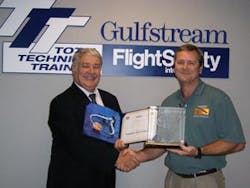Steve King, director of maintenance for Cox Enterprises in Atlanta, GA, has earned FlightSafety’s 1,000th Master Technician certification.
King earned his coveted Master Technician designation in June at FlightSafety’s Savannah Maintenance Learning Center when he completed his Operational Maintenance Procedures course for the Gulfstream GV. It’s his second Master Technician certificate — he also earned one for the Gulfstream GIV. And he’s on track to earn a third, for the Hawker 800XP, meaning he’ll be a Master Technician for all three aircraft types in his flight department.
FlightSafety International’s Master Technician professional development training was developed to enhance aircraft technicians’ career opportunities by rewarding proficiency and increasing recognition in the industry.
The Master Technician, Master Technician Management Endorsement, and Master Technician Avionics programs offer a progressive curriculum that takes technicians through initial training courses to advanced operational maintenance procedures.
FlightSafety has worked closely with aircraft manufacturers in developing the programs getting their input and aircraft data on specific systems. It has also received endorsements from NCATT and the American Council on Education (ACE). ACE has approved courses for college credit, a 70-hour course at FlightSafety equals four upper division college credit hours.
According to FlightSafety’s Keith McGann, Getting Master Technician certification isn’t simple. It takes about four years, meeting once a year as you get more experience on specific aircraft. To get certification you must pass a closed book exam with a score of 90 percent or above. “You have to work at this,” McGann says, “you have to want it and prove to your peers that you’re worthy. You can’t just come to class.”
The Master Technician program begins with an initial type-specific training course, continuing with updates on the aircraft, engine run, taxi training, and troubleshooting. It concludes with operational maintenance procedures to see how fast a technician can return the aircraft to service.
“It’s a win, win, win for the technician, the employer, and the industry,” Doug
Bowen, worldwide director of maintenance training for FlightSafety, says. “The Master Technician training goes a long way toward improving safety and reducing downtime.”
The Master Technician Avionics certification includes two mandatory training courses, Electrical/Electrician Technician and Avionics; any initial-level aircraft-specific course in Avionics Work, Electrical and Avionics, or EASA; a systems-specific skill enhancements course; an advanced aircraft-specific course; and an aircraft-specific operational maintenance procedures course.
The Master Technician Management Endorsement certificate (developed with cooperation of Global Jet Services) includes two mandatory core courses: Aviation Interpersonal Maintenance Management (AIMM) course and either Maintenance Initial/Manager or Maintenance Update /Operational Maintenance Procedures (OMP). Elective courses, of which you can choose three, include FAR Part 145 Repair Station Training, FARs for AMTs, Principles of Advanced Composite Structures Repair, OSHA/EPA Training, Maintenance Resource Management (MRM) and/or Human Factors, Reduced Vertical Separation Mimimum (RVSM), Safety Management Systems, Principles of Troubleshooting, and Line/Advanced Avionics.
For more information visit www.flightsafety.com, call (800) 291-0679, or email [email protected].





